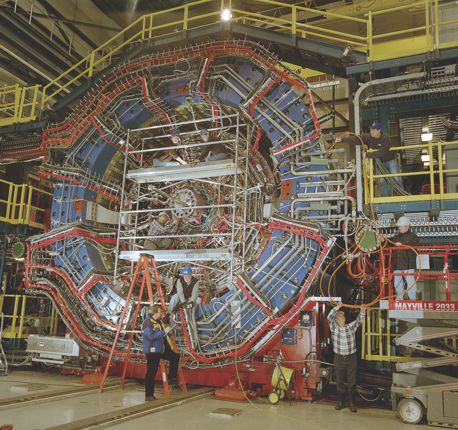Axe hangs over RHIC
DOI: 10.1063/PT.3.1914
On 28 January a 21-member subpanel of the Nuclear Science Advisory Committee (NSAC) charged with making tough choices for US nuclear physics presented its recommendations. Without more money, one of the field’s three main facilities will have to be shut down; the subpanel fingered the Relativistic Heavy Ion Collider at Brookhaven National Laboratory. (The solenoid tracker, pictured below, is one of RHIC’s two major detectors.)

Brookhaven National Laboratory

But the subpanel noted that with a “modest” annual increase of 1.6% above inflation in the nuclear sciences budget, all three facilities could continue, with RHIC and the Continuous Electron Beam Accelerator Facility (CEBAF) at Jefferson Lab in Virginia running on reduced schedules and construction proceeding on the Facility for Rare Isotope Beams (FRIB) at Michigan State University. The Department of Energy and NSF charged NSAC with revisiting the field’s priorities last year, when President Obama’s budget request for nuclear physics in fiscal year 2013 came in $20.4 million lower than the previous year (see Physics Today, November 2012, page 26
“RHIC has a lot it can still do,” says Texas A&M University’s Robert Tribble, who chaired the NSAC subpanel. “It’s a real tragedy if we have to shut down. But if we don’t build FRIB, the future also looks dim.” Even under the modest growth scenario, NSAC member Allena Opper of George Washington University worried that “we will be asked to do more with less, and inevitably do nothing well. That is fatal.”
A key concern brought up by NSAC members was that if the government doesn’t invest in nuclear physics, neither will universities, and the field will have trouble recruiting young people. Karlheinz Langanke, of the GSI Helmholtz Center for Heavy Ion Research in Darmstadt, Germany, and a member of NSAC, said he was “shocked about the perspectives for young people” if one of the US facilities is closed.
Hugh Montgomery, director of Jefferson Lab, said at the presentation that he finds the budget situation “especially galling. I believe this field has done an excellent job of positioning itself, and all aspects are in a position of world leadership.” He and the directors of Brookhaven and FRIB intend to work together to lobby Congress for more money. “If Congress gets their act together, we may or may not be forced to do something drastic,” says Tribble. “What we have to do is try to have the nuclear science community push as hard as we can to keep us from imploding.”
More about the Authors
Toni Feder. tfeder@aip.org
